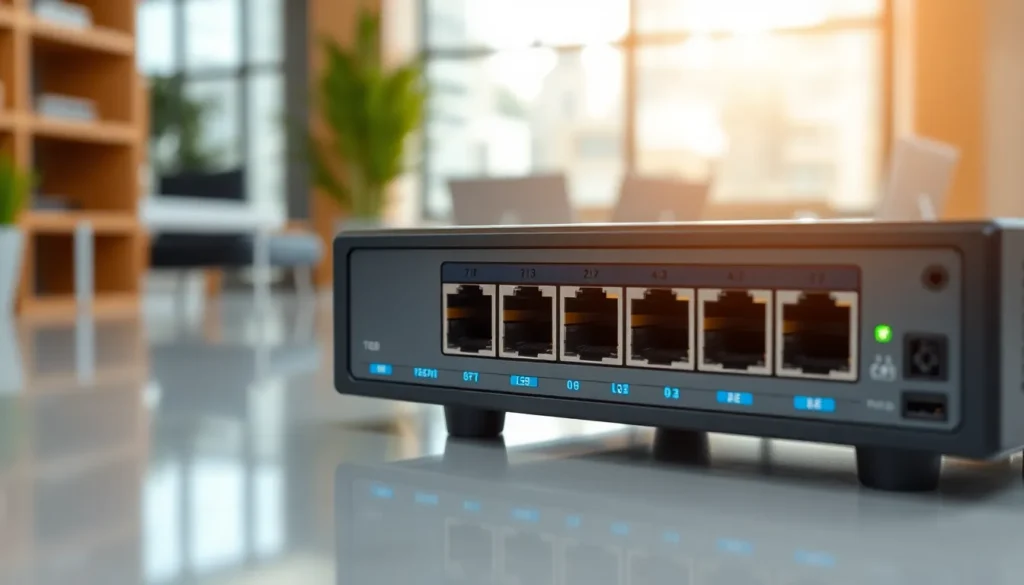Table of Contents
ToggleIn the digital age, understanding IP addresses is crucial for navigating the internet’s complex landscape. One such address, 10.24.1.0.157, holds significance in various networking contexts. Whether it’s for troubleshooting connectivity issues or managing network configurations, grasping the nuances of this specific IP can enhance both security and efficiency.
This article delves into the details of 10.24.1.0.157, exploring its role within private networks and its implications for data management. Readers will discover how this address fits into the broader framework of IP addressing and the importance of recognizing its function in ensuring seamless communication across devices. Understanding this address not only empowers tech-savvy individuals but also aids businesses in optimizing their network performance.
Overview of 10.24.1.0.157
10.24.1.0.157 functions as a private IP address within the Class A range. This address enables communication between devices in local networks, making it pivotal for internal networking tasks. Organizations utilize such addresses to establish efficient network configurations, ensuring seamless connectivity among devices.
10.24.1.0.157 often appears in settings like routers and gateways, assisting network administrators in managing data traffic. The address serves as a part of the private IP address space defined by the Internet Engineering Task Force, where it aids in preventing IP address conflicts among local devices.
Network management benefits from 10.24.1.0.157 through practices like subnetting and address assignment. Subnetting allows for efficient organization of devices, while static IP assignments to critical servers or printers ensure reliable access.
Troubleshooting connectivity issues relies heavily on understanding addresses like 10.24.1.0.157. Admins often track network performance metrics associated with this address to identify potential bottlenecks or disruptions in communication.
Features of 10.24.1.0.157
The address 10.24.1.0.157 offers several key features that enhance its utility in networking. Understanding these features is vital for professionals managing local networks.
Network Configuration
Network configuration with 10.24.1.0.157 involves setting up devices for optimal communication. It acts as an essential component in defining local area networks (LANs). Using this address, administrators can assign static IPs to critical devices, promoting stability. This practice reduces the risk of address conflicts and ensures that devices like printers and servers maintain consistent connectivity. Additionally, 10.24.1.0.157 aids in subnetting, allowing for effective segmentation within the network. By dividing a single network into smaller subnetworks, administrators can improve efficiency and security.
Security Protocols
Security protocols associated with 10.24.1.0.157 provide protection within local networks. These protocols, such as WPA2 or IPsec, help safeguard data transmitted across devices. Implementing these security measures reduces vulnerability to unauthorized access and attacks. By using firewalls in conjunction with this IP address, organizations can monitor and filter incoming and outgoing traffic. This monitoring mechanism ensures that only authorized connections occur, enhancing overall network security. Employing regular updates of security software also strengthens defenses against potential threats targeting devices using this address.
Advantages of Using 10.24.1.0.157
- Streamlined Communication: 10.24.1.0.157 enables efficient communication between devices within local networks, promoting quick data exchange and enhanced collaboration among users.
- Private Networking: As a private IP address, 10.24.1.0.157 functions within a secure environment, reducing exposure to external threats and enhancing overall data privacy.
- Effective Network Management: This address supports organizational structures in network management, allowing administrators to monitor traffic patterns and identify issues without external interference.
- Reduced Conflict Risks: Utilizing 10.24.1.0.157 decreases the chances of IP address conflicts, especially when combined with static IP assignments, ensuring consistent connectivity for critical devices.
- Facilitated Subnetting: The address supports subnetting practices, which improve network efficiency by dividing larger networks into manageable segments, optimizing performance and security.
- Enhanced Security Protocols: 10.24.1.0.157 integrates seamlessly with security measures such as WPA2 and IPsec, providing layered protection for data transmitted across the network.
- Eases Troubleshooting: This IP address aids network administrators in promptly identifying connectivity issues, as tracking performance metrics associated with it leads to faster resolution of potential disruptions.
- Scalability Options: Organizations can expand their networks efficiently around 10.24.1.0.157, allowing for additional devices without significant reconfiguration.
- Cost-Effectiveness: Using a private IP address like 10.24.1.0.157 reduces costs associated with external IP addresses and related services, benefiting organizations in resource allocation.
- Compatibility with Modern Devices: 10.24.1.0.157 is compatible with a wide range of devices, facilitating integration across various platforms in a diverse networking environment.
Potential Issues with 10.24.1.0.157
Network administrators may encounter several issues when managing the IP address 10.24.1.0.157. Understanding these potential problems is crucial for maintaining network performance and reliability.
Common Problems
- IP Address Conflicts
IP address conflicts occur when two devices attempt to use the same IP address. This can disrupt communication and create connectivity issues. Ensuring unique IP assignments within the network prevents such conflicts.
- Subnetting Errors
Incorrect subnetting can lead to improper network segmentation. This causes communication errors between devices in different subnets. Accurate subnet calculations are essential for maintaining efficient communication pathways.
- Device Misconfiguration
Administrators may misconfigure network devices that use 10.24.1.0.157, leading to connectivity problems. Regular audits of device settings can catch misconfigurations early.
- Firewall Restrictions
Firewall settings may inadvertently block traffic to or from 10.24.1.0.157. Regular reviews of firewall policies ensure necessary communications flow without issues.
- Limited Security Protocols
Relying solely on basic security measures for 10.24.1.0.157 can expose the network to vulnerabilities. Implementing robust security protocols, such as WPA2 and IPsec, enhances data protection.
Troubleshooting Tips
- Verify IP Assignments
Ensure that no duplicate IP addresses exist. Utilize network tools to identify any conflicting devices and reassign IPs as necessary.
- Check Subnet Configurations
Review the subnet settings to confirm that devices are within the correct subnet. Consider recalibrating subnet masks if communication issues arise.
- Review Device Settings
Conduct routine checks on all devices using 10.24.1.0.157 to ensure they are configured correctly. Update device firmware to avoid compatibility issues.
- Examine Firewall Rules
Analyze firewall configurations to ensure they permit traffic intended for 10.24.1.0.157. Adjust rules as necessary to enable required communications.
- Enhance Security Measures
Regularly update security protocols to safeguard data associated with 10.24.1.0.157. Ensure that all devices adhere to current security practices to minimize threats.
- Utilize Network Monitoring Tools
Deploy network monitoring tools to track performance metrics related to 10.24.1.0.157. Monitoring can pinpoint bottlenecks and facilitate quick resolutions.
Usage Scenarios for 10.24.1.0.157
10.24.1.0.157 serves various purposes within private networks, enhancing connectivity and facilitating effective network management.
- Local Area Network (LAN) Configuration: 10.24.1.0.157 plays a vital role in establishing LANs. It supports static IP assignments, ensuring that critical devices maintain consistent addresses, which stabilizes network connections.
- Device Management: Network administrators utilize 10.24.1.0.157 to monitor and manage devices on the network. By assigning this address to routers and switches, they optimize data flow and prevent bottlenecks.
- Troubleshooting: During network disruptions, 10.24.1.0.157 aids in diagnosing connectivity issues. Administrators can track performance metrics associated with this address, isolating problems and enhancing overall network reliability.
- Subnetting: 10.24.1.0.157 contributes to subnetting strategies, allowing the segmentation of larger networks into manageable subnetworks. This practice enhances performance and security by limiting broadcast traffic and isolating network segments.
- Data Privacy and Security: As a private IP address, 10.24.1.0.157 improves data privacy. It minimizes exposure to outside threats and supports various security protocols, such as WPA2 and IPsec, ensuring secure communications across devices.
- Network Scalability: 10.24.1.0.157 supports network expansion. Organizations can easily add devices without reconfiguring existing IP addresses, facilitating growth and adaptability.
- Integration with Modern Devices: 10.24.1.0.157 is compatible with a wide range of devices. This versatility ensures seamless integration across different technologies, accommodating various networking environments.
- Cost-Effectiveness: Using 10.24.1.0.157 helps minimize costs associated with public IP addresses. Organizations can manage multiple devices internally, reducing reliance on external IP allocations.
- Firewall Configuration: 10.24.1.0.157 is essential in configuring firewall rules. Properly set rules help protect the network from unauthorized access while allowing legitimate traffic to flow uninterrupted.
- Monitoring Network Performance: Administrators leverage 10.24.1.0.157 for ongoing network assessments. Utilizing network monitoring tools, they observe traffic patterns and address anomalies proactively to maintain optimal performance.
Conclusion
Understanding the role of 10.24.1.0.157 is essential for effective network management. This private IP address serves as a cornerstone for seamless communication within local networks. By implementing best practices around its use, network administrators can enhance performance and security.
The address not only facilitates efficient data exchange but also supports critical tasks like subnetting and device management. Organizations that prioritize the proper configuration of 10.24.1.0.157 can expect improved connectivity and reduced risks of IP conflicts. With the right strategies in place, this IP address can significantly contribute to a secure and reliable networking environment.




